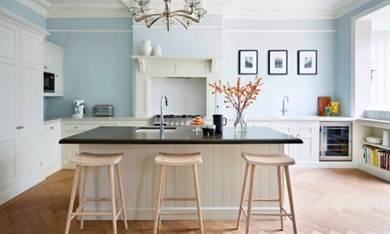News
Going Green - How to Design an Eco-Friendly Kitchen
While some say it isn't easy being green, Harvey Jones beg to differ. There are a growing number of solutions and designs that can make a home both more sustainable and stylish - and where better to start than the household's central hub: the kitchen?
Bear in mind, however, that an eco-friendly kitchen is not just one with proper recycling processes, energy-efficient light bulbs, and a sink cupboard stocked with reusable shopping bags. In fact, you'd be surprised at some of the innovations - big and small - that are currently making waves in the interior design industry.
Ensuring your kitchen benefits the environment doesn't mean you need to compromise on style, aesthetic or decor, though. To prove the point, Harvey Jones ahve compiled a list of the top sustainable kitchen ideas to start your journey to greener living.
1. MAKE YOUR OVEN ELECTRIC
Gas stoves are a significant source of indoor air pollution and produce more pollutants than other types of fuel, which is why we recommend switching to an electric-powered alternative. This not only mitigates the risk of exposure to hazardous chemicals but also reduces the use of non-renewable fossil fuels, which are the biggest contributor to global warming.
Buying a second-hand oven is another eco-friendly option, as these kinds of purchases help to maintain consumer demand for recycled and reclaimed products, creating a positive environmental impact further down the line.
2. INTEGRATE RECYCLED MATERIALS
Look for furniture and appliances that feature reclaimed cork, timber, lino or bamboo, as this prevents materials from ending up in a landfill. Stainless steel, glass and porcelain are also often recycled, so incorporating these in the kitchen sink, lights and tiles is therefore another fantastic way of reducing your carbon footprint.
You needn't worry about these materials diminishing your kitchen's overall appearance, as recycled products can be just as stylish. Consider quartz composite work surfaces, which is innately eco-friendly, as the natural materials are sourced from the earth while being durable and recyclable after use. Although you could feasibly go for recycled glass instead, this is fragile and known to crack under intense pressure.
3. BUY SECOND-HAND
Beyond recycling, why not cut out the middle-man altogether and the subsequent carbon footprint by purchasing second-hand appliances and furnishings? The eco benefits of shopping second-hand are many: it saves waste and reduces emissions created from disposing of perfectly good appliances.
That said, as items are second-hand, it's worth checking before buying for any faults. Don't skimp on the fitting process either, as you may not have the original installation instructions if the item is previously-owned - get a professional to do it for you.
4. CHOOSE ECO-FRIENDLY FLOORING
Did you know you can even make your kitchen flooring eco-friendly? While you might have seen some stunning tiles in a local kitchen showroom, the quality of second-hand tiles isn't to be ignored. You can also use reclaimed wood flooring, though this can sometimes be more costly than brand new wood. In which case, sustainably sourced bamboo and hardwood are fantastic options that will look no less impressive.
When searching for eco-friendly materials, look out for the Forest Stewardship Council (FSC) logo - this signifies that the world's forest ecosystems have not been harmed in the manufacturing process.
5. INVEST IN SUSTAINABLE KITCHEN CABINETS
We mentioned using bamboo and hardwood to achieve sustainable flooring, and this extends to your cabinetry as well. Kitchen cabinets can be constructed using reclaimed or lyptus wood, the latter being a more environmentally-conscious choice because the tree it comes from is fast-growing and can be harvested in a relatively short time-frame of 20 years.
You should make sure all wood used in your design is formaldehyde-free too. This is a carcinogenic chemical that breaks down and releases harmful substances like formic acid and carbon monoxide, causing damage to our health and the world's ecosystems.
6. ENSURE YOUR SURFACES ARE DURABLE
Alongside quartz composites, there are plenty other ways to integrate durable and sustainable work surfaces. Wood countertops are an enduring favourite offering a natural texture and bringing warmth to the space., However, these are not always the most long-lasting option, even if they are recyclable. Opting for a surface that will stand the test of time is one of the most important things to consider for a sustainable kitchen.
7. OPTIMISE WATER USAGE
Dishwashers are a fantastic way to make the most efficient use of water, compared to hand-washing pots and pans in the sink which increases water waste. You can also install timers under the sink, as these switch off the tap once the faucet is full to prevent superfluous usage and potential over-filling.
Another eco-friendly solution is to fit a boiling water tap, rather than a kettle. This causes less water to be wasted, as you can only pour in as much as you need each time. It will also reduce energy consumption that is required to boil the kettle. Investing in a filter tap will additionally help you to reduce a great deal of plastic waste, as if you prefer filtered water, you will no longer have to buy bottled water for your contaminant-free H2O.
8. USE SUSTAINABLE PAINT
Eco-paints do not have any volatile organic compounds (VOCs), which are detrimental to your kitchen's air quality. Not only are paint fumes a damaging source of indoor pollution, the atmospheric emissions can be harmful due to the substances they contain, such as solvents, biocides and softening agents.
As such, you should decorate your kitchen with natural paint instead, as this has lower VOC content and is readily available from many manufacturers. There are also many brands producing sustainable, plastic-free paints that cut out single-use packaging and use more eco-friendly supply-chains, such as Tikkurila, Farrow and Ball or the carbon neutral UK brand Coat, that use recycled tin for their cans. In fact, going with a hand-painted kitchen, rather than using spray-paint, is a much more sustainable choice as it allows for easy repainting that does not rely on lacquers or laminates with a high VOC content.
9. ENSURE EFFICIENT LIGHTING
You should aim to allow as much natural light in your space as possible as this lets you light your home without using energy - we specifically advise incorporating skylights or French doors and windows. Once you have established exactly how much natural light your kitchen is getting, the more straightforward it will be to think about where to install artificial solutions. Though, be sure to observe the levels of natural light throughout the day as this can change considerably, depending on the direction your kitchen faces.
For your artificial lighting, you should avoid light bulbs with significant amounts of light-emitting diodes (LEDs). These contain toxic chemicals such as mercury, that releases dangerous emissions into the atmosphere when thrown away. Energy-efficient light bulbs like compact fluorescent lamps (CFLs) last a lot longer than LEDs, with the amount of energy saved here compensating for extra cost once they've been used for around a month. It's also possible to source lights from recycled glass and lens materials.
10. SHOP LOCAL
Buy materials from nearby kitchen suppliers, especially if they sell sustainable, locally-sourced products. This will help to reduce the environmental impact of your installation, as shorter transportation times means less non-renewable energy is used.
Harvey Jones regularly review their supply chains and production processes to ensure these are carefully managed to minimise any wastage of raw materials.
Harvey Jones Kitchens
20 - 22 The Exchange
Nottingham
NG1 2DD
T: 0115 924 3600
www.harveyjones.com





